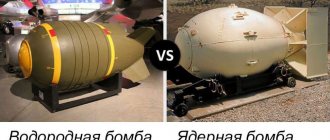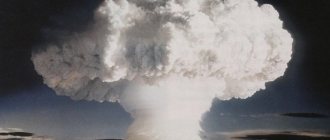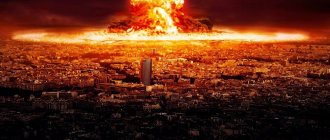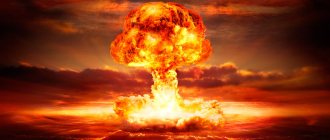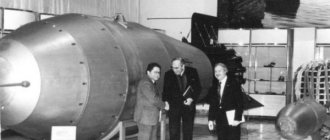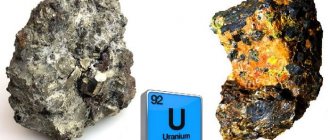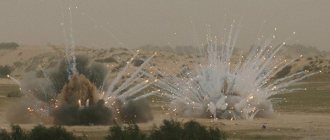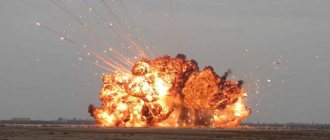Over the 50 years from the discovery of nuclear fission at the beginning of the 20th century until 1957, dozens of atomic explosions occurred. Thanks to them, scientists gained especially valuable knowledge about the physical principles and models of atomic fission. It became clear that it was impossible to increase the power of an atomic charge indefinitely due to physical and hydrodynamic restrictions on the uranium sphere inside the warhead.
Therefore, another type of nuclear weapon was developed - the neutron bomb. The main damaging factor in its explosion is not the blast wave and radiation, but neutron radiation, which easily affects enemy personnel, leaving equipment, buildings and, in general, the entire infrastructure intact.
History of creation
They first thought about creating a new weapon in Germany in 1938, after two physicists Hahn and Strassmann split the uranium atom artificially. A year later, construction began on the first reactor in the vicinity of Berlin, for which several tons of uranium ore were purchased. Since 1939 Due to the outbreak of war, all work on atomic weapons is classified.
The program is called the “Uranium Project”. In 1944, Heisenberg's group produced uranium plates for the reactor. It was planned that experiments to create an artificial chain reaction would begin at the beginning of 1945. But due to the transfer of the reactor from Berlin to Haigerloch, the experiment schedule shifted to March. According to the experiment, the fission reaction in the installation did not start, because the mass of uranium and heavy water was below the required value (1.5 tons of uranium when the requirement was 2.5 tons).
In April 1945, Haigerloch was occupied by the Americans. The reactor was dismantled and the remaining raw materials were taken to the USA. In America, the nuclear program was called the “Manhattan Project”. The physicist Oppenheimer became its leader together with General Groves. Their group also included German scientists Bohr, Frisch, Fuchs, Teller, Bloch, who left or were evacuated from Germany.
A plutonium warhead in the form of an aerial bomb (“Fat Man”) was dropped on Nagasaki on August 9, 1945. The gun-type uranium bomb (“Baby”) was not tested at the test site in New Mexico and was dropped on Hiroshima on August 6, 1945.
Work on the creation of its own atomic weapons in the USSR began in 1943. Soviet intelligence reported to Stalin about the development in Nazi Germany of super-powerful weapons that could change the course of the war. The report also contained information that, in addition to Germany, work on the atomic bomb was also carried out in the Allied countries.
To speed up work on the creation of atomic weapons, intelligence officers recruited physicist Fuchs, who was participating in the Manhattan Project at that time. Leading German physicists Ardenne, Steinbeck, and Riehl associated with the “uranium project” in Germany were also brought to the Union. In 1949, a successful test of the Soviet RDS-1 bomb took place at a test site in the Semipalatinsk region of Kazakhstan.
Increasing the amount of uranium in the charge leads to its activation as soon as the critical mass is reached. Scientists have tried to solve this problem by creating different arrangements, dividing the uranium into many parts (in the form of an open orange) that were connected together during the explosion. But this did not allow a significant increase in power. Unlike an atomic bomb, the fuel for thermonuclear fusion does not have a critical mass.
The first proposed hydrogen bomb design was the "classic super", developed by Teller in 1945. In essence, it was the same atomic bomb, inside which a cylindrical container with a deuterium mixture was placed.
In the fall of 1948, USSR scientist Sakharov created a fundamentally new design for a hydrogen bomb - the “puff layer”. It used uranium-238 as a fuse instead of uranium-235 (the U-238 isotope is a waste from the production of the U-235 isotope), and lithium deutride became the source of tritium and deuterium at the same time.
The bomb consisted of many layers of uranium and deuteride. The first thermonuclear bomb RDS-37 with a power of 1.7 Mt was exploded at the Semipalatinsk test site in November 1955. Subsequently, its design, with minor changes, became classic.
golden rocket
Much greater prospects for new weapons have opened up in missile defense. Due to the lack of accuracy of Cold War guidance systems, ballistic missiles were supposed to be destroyed by nuclear-powered interceptors. However, outside the atmosphere, the shock and heat waves of a nuclear explosion have no effect. And a nuclear explosion in the atmosphere leaves unwanted pollution.
The order to create a unique cruise missile in the USSR has been declassified
Neutron fluxes work equally effectively both in the atmosphere and outside it. Passing through the plutonium of a nuclear warhead, they cause a premature chain reaction in it without reaching a critical mass. In the United States, this phenomenon was called the “fizzy effect” - a megaton-class warhead exploded like a firecracker at a children's party. In addition, the operation of neutron weapons is accompanied by soft X-ray radiation - it instantly evaporates the shell of an enemy thermonuclear charge, spraying it into the atmosphere.
The American LIM-49A Spartan anti-missile missile, which entered service in 1975, carried a five-megaton neutron warhead; to increase the flow of particles, its inner surface was coated with a layer of gold. The interceptors that replaced the Spartan are also equipped with neutron warheads. According to open sources, similar technologies are used in the missiles of the Russian A-135 Amur missile defense system.
How a neutron bomb works - features of damaging factors
A neutron bomb is a type of nuclear weapon, the main damaging factor of which is the flow of neutron radiation. Contrary to popular belief, after a neutron munition explodes, both a shock wave and light radiation are generated, but most of the energy released is converted into a stream of fast neutrons. The neutron bomb is a tactical nuclear weapon.
The operating principle of neutron munitions is based on the property of fast neutrons to penetrate much more strongly through various barriers, compared to X-rays, alpha, beta and gamma particles. For example, 150 mm of armor can hold up to 90% of gamma radiation and only 20% of a neutron wave. Roughly speaking, it is much more difficult to hide from the penetrating radiation of a neutron weapon than from the radiation of a conventional nuclear bomb.
It was this property of neutrons that attracted the attention of the military.
A neutron bomb has a low-power nuclear charge, as well as a special block (usually made of beryllium), which is the source of neutron radiation. After a nuclear charge is detonated, most of the explosion energy is converted into hard neutron radiation. The remaining factors of damage - shock wave, light pulse, electromagnetic radiation - account for only 20% of the energy.
However, all of the above is just a theory; the practical use of neutron weapons has some nuances.
The earth's atmosphere very strongly dampens neutron radiation, so the range of this damaging factor is no greater than the range of the shock wave. For the same reason, there is no point in producing high-power neutron ammunition - the radiation will quickly fade anyway. Typically, neutron charges have a power of about 1 kT. When it is detonated, neutron radiation damage occurs within a radius of 1.5 km. At a distance of 1350 meters from the epicenter, it is dangerous for human life.
In addition, the flow of neutrons causes induced radioactivity in materials - for example, in armor. If you put a new crew in a tank that has been exposed to neutron weapons (at a distance of about a kilometer from the epicenter), they will receive a lethal dose of radiation within 24 hours.
The widespread belief that a neutron bomb does not destroy material assets is not true. After the explosion of such ammunition, both a shock wave and a pulse of light radiation are formed, the zone of severe destruction from which has a radius of approximately one kilometer.
Neutron munitions are not very suitable for use in the earth's atmosphere, but they can be very effective in outer space. There is no air there, so neutrons travel unhindered over very long distances. Due to this, various sources of neutron radiation are considered as an effective means of missile defense. This is the so-called beam weapon. True, it is not neutron nuclear bombs that are usually considered as a source of neutrons, but generators of directed neutron beams - the so-called neutron guns.
The developers of Reagan's Strategic Defense Initiative (SDI) program proposed using them as a means to destroy ballistic missiles and warheads. When a beam of neutrons interacts with the construction materials of missiles and warheads, induced radiation is generated, which reliably disables the electronics of these devices.
After the idea of a neutron bomb appeared and work began on its creation, methods of protection against neutron radiation began to be developed. First of all, they were aimed at reducing the vulnerability of military equipment and the crew located in it. The main method of protection against such weapons was the manufacture of special types of armor that absorb neutrons well. Usually they added boron - a material that perfectly captures these elementary particles. It can be added that boron is part of the absorber rods of nuclear reactors. Another way to reduce the neutron flux is to add depleted uranium to armor steel.
In general, almost all military equipment created in the 60s and 70s of the last century is maximally protected from most of the damaging factors of a nuclear explosion.
Railgun
The theoretical limit for the initial speed of an artillery shell is about 2 km/s. But in practice it is not achievable either. In the new age of high speeds, the military is demanding more from scientists. And, perhaps, very soon electromagnetic guns will appear instead of conventional artillery guns. A railgun, or as it is called in the USA, a railgun, from the standpoint of physics is an electromagnetic mass accelerator. Another type of such an accelerator is the “Gauss gun,” but this device is considered not entirely effective in the case of practical implementation.
The advantages of railguns over conventional artillery are, of course, obvious. The goal set by the American military for the developers is to create an electromagnetic gun capable of accelerating a projectile to a speed of 5.8 km/s. Such a gun should be able to hit a target with a diameter of 5 meters located at a distance of 370 kilometers in six minutes. This is 20 times higher than the firing rates of the artillery weapons currently in service with the US Navy. In addition, one must understand that such projectiles do not contain explosives; their unprecedented armor-piercing power lies only in the kinetic energy of the projectile fired at ultra-high speed. The ships that are planned to carry such weapons will be safer due to the smaller amount of explosives they carry.
Railgun tests in the USA /© wikipedia.org
It is worth saying that the railgun does not necessarily have to become a toy in the hands of the military. When reaching a speed of 7.9 km/s (first escape velocity), it can be used to launch satellites into low-Earth orbit.
Russia is also developing railguns. The first public tests took place this summer at the Shatura branch of the Joint Institute for High Temperatures of the Russian Academy of Sciences. During demonstration tests, a projectile speed of 3.2 km/s was achieved. But, according to the President of the Russian Academy of Sciences Vladimir Fortov, who was present at the tests, the maximum that could be extracted from the device was 11 km/s. True, in our case, scientists do not talk about the military use of railguns. As Fortov stated, scientists at the Academy of Sciences are faced with three tasks: obtaining a system with high pressures and studying the Universe with their help, protecting the planet from high-speed cosmic bodies and putting satellites into orbit.
The principle of operation of Lorentz forces in a railgun /© wikipedia.org
As the name suggests, a railgun (electromagnetic gun) uses electromagnetic force to accelerate a projectile. A railgun is a pair of parallel electrodes (rails) connected to a source of powerful direct current. The projectile, which is part of an electrical circuit (conductor), acquires acceleration due to the Lorentz force, pushing it out and accelerating it to ultra-high speeds.
Vladimir Fortov testing a domestic railgun /© novostimo.ru
Myth 5: The neutron bomb has limited use on earth
The use of neutrons as a destructive element already in the 1960s suggested to the developers of neutron weapons that they could be effectively used in airless space.
From the very beginning, they tried to install neutron weapons on missile defense missiles. In the USA these were Sprint-type missiles with neutron warheads. They were deployed around the largest US air base, Grand Forks (North Dakota).
LaunchSprint"
Nuclear missiles fired by the enemy were supposed to be intercepted at an altitude of a couple of tens of kilometers. At the moment of interception, the neutron charge of the anti-missiles exploded, and the neutron radiation disabled the detonators of the enemy missiles - and at the same time caused a fission reaction in part of the plutonium, which could destroy the enemy missile due to the energy released.
However, despite such rosy plans, this type of missile defense was considered unpromising, and missiles with neutron charges were quickly taken off duty.
An antidote was quickly found for the neutron bomb.” Boron, depleted uranium and new ceramic materials negated its effectiveness. However, at the end of March 2022, the Americans announced that neutron weapons can be very promisingly used in space.
Political and historical consequences
Work on the creation of neutron weapons began in the 60s of the 20th century in the USA. After 15 years, the production technology was improved and the world's first neutron charge was created, which led to a kind of arms race. At the moment, Russia and France have this technology.
The main danger of this type of weapon when used was not the possibility of mass destruction of the civilian population of the enemy country, but the blurring of the line between nuclear war and an ordinary local conflict. Therefore, the UN General Assembly adopted several resolutions calling for a complete ban on neutron weapons.
In 1978, the USSR was the first to propose to the United States an agreement on the use of neutron charges and developed a project to ban them.
Unfortunately, the project remained only on paper, because... not a single Western country or the USA accepted it.
Later, in 1991, the presidents of Russia and the United States signed commitments according to which tactical missiles and artillery shells with a neutron warhead must be completely destroyed. Which undoubtedly will not hurt to organize their mass production in a short time when the military-political situation in the world changes.
Why is nuclear fusion preferable?
During a thermonuclear reaction, which consists in the fusion of the nuclei of the chemical elements participating in it, significantly more energy is generated per unit mass of a physical device than in a pure atomic bomb that implements a nuclear fission reaction.
In an atomic bomb, fissile nuclear fuel quickly, under the influence of the energy of detonation of conventional explosives, combines in a small spherical volume, where its so-called critical mass is created, and the fission reaction begins. In this case, many neutrons released from fissile nuclei will cause the fission of other nuclei in the fuel mass, which also release additional neutrons, leading to a chain reaction. It covers no more than 20% of the fuel before the bomb explodes, or perhaps much less if conditions are not ideal: as in the atomic bombs Little Kid dropped on Hiroshima and Fat Man that hit Nagasaki, efficiency (if such a term can be applied to them) apply) were only 1.38% and 13%, respectively.
The fusion (or fusion) of nuclei covers the entire mass of the bomb charge and lasts as long as neutrons can find thermonuclear fuel that has not yet reacted. Therefore, the mass and explosive power of such a bomb are theoretically unlimited. Such a merger can theoretically continue indefinitely. Indeed, the thermonuclear bomb is one of the potential doomsday devices that could destroy all human life.
Myth 2: the more powerful the neutron bomb, the better
Initially, it was planned to rivet the neutron bomb in several versions - from one kiloton and above. However, calculations and tests have shown that making a bomb larger than one kiloton is not very promising.
So, even if it’s not a bomb, it’s too early to write off the neutron weapon itself as scrap.
When a neutron bomb explodes, the main damaging factor is the neutron flux. It passes through most objects, but causes harm to living organisms at the atomic and particle level. Radiation primarily affects brain tissue, causing shock, convulsions, paralysis and coma. In addition, neutrons transform atoms inside the human body, creating radioactive isotopes that irradiate the body from the inside. Death does not occur instantly, but within 2 days.
If a neutron charge is dropped on a city, the bulk of buildings within a radius of 2 kilometers from the epicenter of the explosion will be preserved, while people and animals will die. For example, it was estimated that 10-12 bombs would be enough to destroy the entire population of Paris. Those residents who manage to survive will suffer from radiation sickness for years.
“An ominous prototype of such a weapon was the atomic bomb dropped by an American pilot on August 6, 1945 on Hiroshima. It has now been established that when this bomb (uranium) exploded, it produced 4-5 times more neutrons than the bomb exploded in Nagasaki (plutonium). And as a result, almost 3 times more people died in Hiroshima than in Nagasaki, although the power of the bomb dropped on Hiroshima was half as much,” wrote the author of the book “Beyond Legality,” Ivan Artsibasov, in 1986.
The use of a bomb with a source of fast neutrons (berrylium isotope) was proposed in 1958 by the American physicist Samuel Cohen. For the first time, the US military tested such a charge 5 years later at an underground test site in Nevada.
The charge is structurally a conventional low-power nuclear charge, to which is added a block containing a small amount of thermonuclear fuel (a mixture of deuterium and tritium). When detonated, the main nuclear charge explodes, the energy of which is used to trigger a thermonuclear reaction. Most of the explosion energy when using neutron weapons is released as a result of the triggered fusion reaction. The design of the charge is such that up to 80% of the explosion energy is the energy of the fast neutron flow, and only 20% comes from the remaining damaging factors (shock wave, EMR, light radiation).
History
The Neutrino Bomb first appeared in the “Pilot” episode and presumably radiates lethal amounts of neutrinos when detonated. Because neutrinos can pass through matter almost unimpeded, a sufficient intensity of neutrinos will travel through the earth and deliver a lethal dose to the entire population in a fraction of a second. In a drunken stupor Rick planned to launch this bomb from his ship, intending to spare only himself, Morty, and Morty's crush Jessica. The bomb is shown arming itself but it is not known whether it detonates. In "The Vindicators 3: The Return of Worldender" it is revealed that Rick's neutrino bombs have a 40% chance to be duds and that Morty has disarmed several during Rick's drunken escapades.
Young but promising
The need to quickly develop Soviet nuclear weapons became obvious when, in 1942, intelligence reports revealed that scientists in the United States had made great progress in nuclear research. This was indirectly indicated by the complete cessation of scientific publications on this topic back in 1940. Everything indicated that work on creating the most powerful bomb in the world was in full swing.
On September 28, 1942, Stalin signed a secret document “On the organization of work on uranium.”
Bomb_12
Igor Vasilievich Kurchatov
Photo: press service of the National Research Center "Kurchatov Institute"
The leadership of the Soviet atomic project was entrusted to the young and energetic physicist Igor Kurchatov, who, as his friend and colleague Academician Anatoly Alexandrov later recalled, “has long been perceived as the organizer and coordinator of all work in the field of nuclear physics.” However, the sheer scale of the work that the scientist mentioned was still small - at that time in the USSR, in Laboratory No. 2 (now the Kurchatov Institute) specially created in 1943, only 100 people were engaged in the development of nuclear weapons, while in the USA they were working on similar About 50 thousand specialists worked on the project.
Therefore, work in Laboratory No. 2 was carried out at an emergency pace, which required both the supply and creation of the latest materials and equipment (and this in wartime!), and the study of intelligence data, which managed to obtain some information about American research.
“Reconnaissance helped speed up the work and reduce our efforts by about a year,” said Andrei Gagarinsky, advisor to the director of the Kurchatov Institute Research Center. — In Kurchatov’s “reviews” about intelligence materials, Igor Vasilyevich essentially gave the intelligence officers tasks about what exactly the scientists would like to know.
Damaging factors
Atomic weapons have the following destruction factors:
- Radioactive contamination.
- Light radiation.
- Shock wave.
- Electromagnetic pulse.
- Penetrating radiation.
The consequences of an atomic bomb explosion are disastrous for all living things. Due to the release of a huge amount of light and heat energy, the explosion of a nuclear projectile is accompanied by a bright flash. The power of this flash is several times stronger than the sun's rays, so there is a danger of damage from light and thermal radiation within a radius of several kilometers from the point of the explosion.
Another dangerous damaging factor of atomic weapons is the radiation generated during the explosion. It lasts only a minute after the explosion, but has maximum penetrating power.
The shock wave has a very strong destructive effect. She literally wipes out everything that stands in her way. Penetrating radiation poses a danger to all living beings. In humans, it causes the development of radiation sickness. Well, an electromagnetic pulse only harms technology. Taken together, the damaging factors of an atomic explosion pose a huge danger.
Protection
Neutron ammunition was developed in the 1970s, mainly to increase the effectiveness of hitting armored targets and manpower protected by armor and simple shelters. Armored vehicles of the 1960s, designed taking into account the possibility of using nuclear weapons on the battlefield, are extremely resistant to all their damaging factors.
Naturally, after reports appeared about the development of neutron weapons, methods of protection against them began to be developed. New types of armor have been developed, which are already capable of protecting equipment and its crew from the flow of neutrons. For this purpose, sheets with a high content of boron, which is a good neutron absorber, are added to the armor (for the same reason, boron is one of the main structural materials of reactor neutron absorber rods), and the armor is made multilayer, including elements made of depleted uranium. In addition, the composition of the armor is selected so that it does not contain chemical elements that produce strong induced radioactivity under the influence of neutron irradiation.
It is quite possible that such protection will be effective against neutron guns currently existing in projects and prototypes, which also use fluxes of high-energy neutrons.
Thermonuclear explosion sequence
When a primary atomic bomb detonates, in the first moments of this process a powerful X-ray radiation (neutron flux) is generated, which is partially blocked by the neutron shield, and is reflected from the inner lining of the housing surrounding the secondary charge, so that the X-rays fall symmetrically across its entire length
During the initial stages of a thermonuclear reaction, neutrons from an atomic explosion are absorbed by a plastic filler to prevent the fuel from heating up too quickly.
X-rays initially cause the appearance of a dense plastic foam that fills the space between the housing and the secondary charge, which quickly turns into a plasma state that heats and compresses the secondary charge.
In addition, the X-rays vaporize the surface of the container surrounding the secondary charge. The substance of the container, evaporating symmetrically relative to this charge, acquires a certain impulse directed from its axis, and the layers of the secondary charge, according to the law of conservation of momentum, receive an impulse directed towards the axis of the device. The principle here is the same as in a rocket, only if you imagine that the rocket fuel scatters symmetrically from its axis, and the body is compressed inward.
As a result of such compression of thermonuclear fuel, its volume decreases thousands of times, and the temperature reaches the level at which the nuclear fusion reaction begins. A thermonuclear bomb explodes. The reaction is accompanied by the formation of tritium nuclei, which merge with deuterium nuclei initially present in the secondary charge.
The first secondary charges were built around a rod core of plutonium, informally called a “candle”, which entered into a nuclear fission reaction, i.e., another, additional atomic explosion was carried out in order to further raise the temperature to ensure the start of the nuclear fusion reaction. It is now believed that more efficient compression systems have eliminated the "candle", allowing further miniaturization of bomb design.
Fire ball
It would seem that even soft radiation moving at the speed of light should leave the matter that generated it far behind, but this is not so: in cold air, the range of quanta of Kev energies is centimeters, and they do not move in a straight line, but change the direction of movement, re-emitting with every interaction. Quanta ionize the air and spread through it, like cherry juice poured into a glass of water. This phenomenon is called radiative diffusion.
A young fireball of a 100 kt explosion a few tens of nanoseconds after the end of the fission burst has a radius of 3 m and a temperature of almost 8 million Kelvin. But after 30 microseconds its radius is 18 m, although the temperature drops below a million degrees. The ball devours space, and the ionized air behind its front hardly moves: radiation cannot transfer significant momentum to it during diffusion. But it pumps enormous energy into this air, heating it, and when the radiation energy runs out, the ball begins to grow due to the expansion of hot plasma, bursting from the inside with what used to be a charge. Expanding, like an inflated bubble, the plasma shell becomes thinner. Unlike a bubble, of course, nothing inflates it: there is almost no substance left on the inside, it all flies from the center by inertia, but 30 microseconds after the explosion, the speed of this flight is more than 100 km/s, and the hydrodynamic pressure in the substance — more than 150,000 atm! The shell is not destined to become too thin; it bursts, forming “blisters”.
Neutron source In a vacuum neutron tube, a pulse voltage of one hundred kilovolts is applied between a tritium-saturated target (cathode) 1 and anode assembly 2. When the voltage is maximum, it is necessary that deuterium ions be between the anode and cathode, which need to be accelerated. An ion source is used for this. An ignition pulse is applied to its anode 3, and the discharge, passing along the surface of deuterium-saturated ceramic 4, forms deuterium ions. Having accelerated, they bombard a target saturated with tritium, as a result of which an energy of 17.6 MeV is released and neutrons and helium-4 nuclei are formed. In terms of particle composition and even energy output, this reaction is identical to fusion - the process of fusion of light nuclei. In the 1950s, many believed so, but later it turned out that a “disruption” occurs in the tube: either a proton or a neutron (which makes up the deuterium ion, accelerated by an electric field) “gets stuck” in the target nucleus (tritium). If a proton gets stuck, the neutron breaks away and becomes free.
Which of the mechanisms of transferring the energy of the fireball to the environment prevails depends on the power of the explosion: if it is large, the main role is played by radiation diffusion; if it is small, the expansion of the plasma bubble plays a major role. It is clear that an intermediate case is possible when both mechanisms are effective.
The process captures new layers of air; there is no longer enough energy to strip all the electrons from the atoms. The energy of the ionized layer and fragments of the plasma bubble runs out; they are no longer able to move the huge mass in front of them and noticeably slow down. But what was air before the explosion moves, breaking away from the ball, absorbing more and more layers of cold air... The formation of a shock wave begins.
Reaching Power Limit
What followed was a decade of continuous arms race, during which the power of thermonuclear munitions continually increased. Finally, on October 30, 1961, in the USSR over the Novaya Zemlya test site in the air at an altitude of about 4 km, the most powerful thermonuclear bomb that had ever been built and tested, known in the West as the “Tsar Bomba,” was exploded.
This three-stage munition was actually developed as a 101.5-megaton bomb, but the desire to reduce radioactive contamination of the area forced the developers to abandon the third stage with a yield of 50 megatons and reduce the design yield of the device to 51.5 megatons. At the same time, the power of the explosion of the primary atomic charge was 1.5 megatons, and the second thermonuclear stage was supposed to give another 50. The actual power of the explosion was up to 58 megatons. The appearance of the bomb is shown in the photo below.
Its consequences were impressive. Despite the very significant height of the explosion of 4000 m, the incredibly bright fireball with its lower edge almost reached the Earth, and with its upper edge it rose to a height of more than 4.5 km. The pressure below the burst point was six times higher than the peak pressure of the Hiroshima explosion. The flash of light was so bright that it was visible at a distance of 1000 kilometers, despite the cloudy weather. One of the test participants saw a bright flash through dark glasses and felt the effects of the thermal pulse even at a distance of 270 km. A photo of the moment of the explosion is shown below.
It was shown that the power of a thermonuclear charge really has no limitations. After all, it was enough to complete the third stage, and the calculated power would be achieved. But it is possible to increase the number of stages further, since the weight of the Tsar Bomba was no more than 27 tons. The appearance of this device is shown in the photo below.
After these tests, it became clear to many politicians and military men both in the USSR and in the USA that the limit of the nuclear arms race had come and it needed to be stopped.
Modern Russia inherited the nuclear arsenal of the USSR. Today, Russia's thermonuclear bombs continue to serve as a deterrent to those seeking global hegemony. Let's hope they only play their role as a deterrent and never get blown up.
How technology developed further
The discovery of the French mechanic regarding the alternating current device became widely used only in the 70s of the twentieth century. The thing is that he just invented the first transformer, although the invention required improvement. Based on the created prototype, other scientists worked on its further development. In 1876 P.N. Yablochkov presented an improved model of a transformer. Although it must be said that few changes and additions were made. Eg:
- The scientist used a special rod as a core, onto which the winding was directly wound.
- Instead of the previously used spring plate, he took an induction coil as a basis.
Thanks to the changes made, the operation of the primary winding was carried out according to the prescribed sequence, thereby providing the voltage that was required for the operation of electrical appliances.
But it should be said that the improvement of the first transformer was also carried out by other scientists. It is certainly necessary to mention that Yablochkov made a current-converting device with open cores, which in turn required large amounts of electricity. Some time later, the Hopkinson brothers made a transformer with closed cores in 1882, and this was the start for saving electricity consumption in the future.
The essence of the improvement was that they placed coils with high and low voltage on the core. But the rod itself consisted of wire and steel strips, which were separated from each other by a material with insulating characteristics.
Subsequently, work on improving transformers continued. The reason for this was to reduce electricity consumption, since previous devices consumed quite a lot of it. An important discovery is the invention of the three-phase transformer by the Russian engineer Dolivo-Dobrovolsky in 1890. Based on his calculations, he proved that thanks to a three-phase transformer it is possible to save consumed electricity.
Myth 4: a neutron bomb has a long duration of radioactive radiation
Isaac Asimov once called the neutron bomb a capitalist weapon - it supposedly destroys people, but takes care of material property. Well, who will choose cars instead of people? Only a bourgeois scoundrel.
The neutron bomb destroys only life, not property."
The creators of the bomb assured the US government that it had one reinforced concrete advantage: it did not cause long-term radioactive contamination of the area. They say that in a day the army can occupy the cleared territory without consequences.
Tests and calculations have shown that, unlike any other atomic weapon, a neutron bomb actually practically does not pollute the territory. In the sense that the iron structures will not emit much noise for some time and the radioactive contamination of the area can be easily decontaminated during the battles - and not after several years (or even decades), as with the explosion of a hydrogen bomb.

